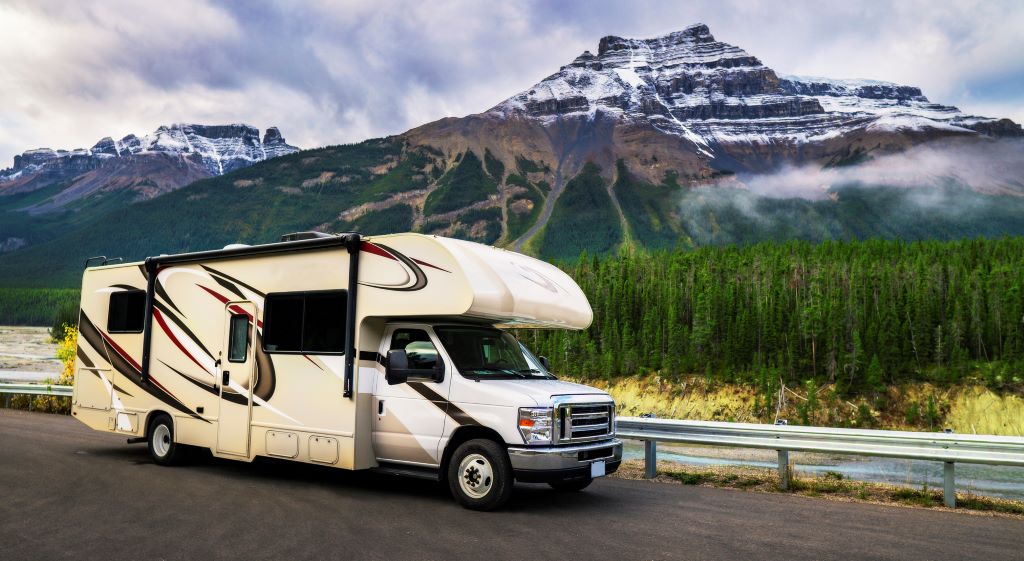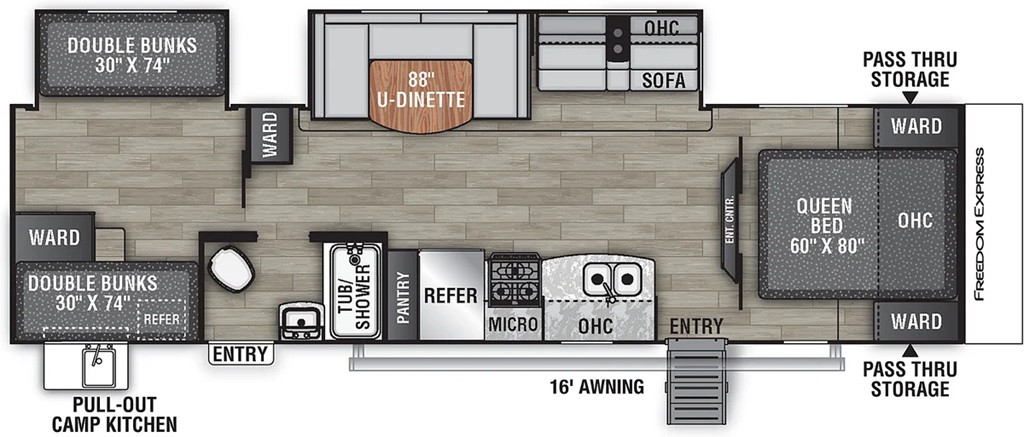How Tall are Travel Trailers? Unlocking Their Vertical Dimensions

The Top 20 Things To Do In Destin, Florida
January 22, 2024Best Cities for Homeless Families: Finding Stability in These Top Metropolises
February 5, 2024How Tall are Travel Trailers? Unlocking Their Vertical Dimensions

When it comes to choosing a travel trailer, knowing its dimensions is crucial. The height, width, and length determine how well it fits into your camping destination, how easy it is to tow, and the living space it provides. In this article, we will explore the dimensions of travel trailers, focusing on their height, width, and length. Travel trailers have varying heights depending on the model and brand.
Table of Contents
ToggleHeight
The height of a travel trailer is an important consideration when planning your camping trips. It determines whether you can drive through low-clearance areas like tunnels or underpasses without any issues. Typically, travel trailers have a height ranging from 8 to 13 feet. However, some models can have a lower or higher profile depending on their design and features.
Width
The width of a travel trailer affects maneuverability and towing stability. It’s essential to know the exact width to ensure easy navigation through narrow roads and parking spaces. On average, travel trailers have a width between 7 to 8.5 feet. This dimension allows for comfortable living space inside while maintaining a manageable width for traveling.
Length
The length of a travel trailer determines the amount of living space and amenities it can offer. It’s important to consider the length to ensure it can fit in your desired camping site and accommodate your needs. Travel trailers come in various lengths, ranging from 10 feet to over 40 feet. The length you choose depends on your preferences, camping style, and the capacity you require.

Factors Impacting Trailer Height
The height of a travel trailer, a key aspect for those who enjoy https://looneynature.com/ adventures, is influenced by several factors, including tire size, suspension, and axle type. Additionally, the overall design and weight distribution of the trailer are critical in determining its height. These elements not only affect the physical dimensions of the trailer but also have a significant impact on its towing dynamics. Proper consideration of these factors is essential for ensuring safe and efficient towing, especially when navigating through various landscapes during your outdoor adventures. Understanding how these elements interplay can help in choosing a travel trailer that aligns with your travel needs and towing capabilities.
Factors Impacting Trailer Height Design and Style Travel trailers come in various sizes and designs, which directly impact their height. The design and style of a travel trailer play a significant role in determining its overall height. Some trailers sport a sleek and low-profile design, while others might have a more boxy and tall structure. The sleek and low-profile design of certain travel trailers enables them to have a lower height, making them more aerodynamic and fuel-efficient. On the other hand, trailers with a boxy and tall structure might provide more interior space but tend to have a greater height. Suspension Type Another factor that impacts the height of travel trailers is the type of suspension they have. There are different suspension systems available, each affecting the overall height of the trailer.
Trailers with leaf spring suspension tend to have a higher ride height compared to those with torsion suspension. Leaf spring suspension consists of stacked metal strips, which offer good load-bearing capacity but can increase the height of the trailer. On the other hand, trailers equipped with torsion suspension have a lower ride height. Torsion suspension uses rubber cords to absorb shocks and vibrations, resulting in a smoother ride while keeping the trailer height in check. Other Factors While design and suspension type are two major factors impacting trailer height, there are a few other considerations to keep in mind as well. – Ground clearance: Some travel trailers are built with higher ground clearance to tackle rough terrain or off-road adventures.
For the best lightweight travel trailers under 7000 lbs, designed for enhanced off-road performance, increased height is a common characteristic. This is often to accommodate larger wheels and more robust suspension systems. Additionally, the inclusion of various appliances and features can contribute to the travel trailer’s height. Common installations like air conditioning units, vent fans, and satellite dishes are typically mounted on the roof, adding to the overall height of the trailer. Furthermore, optional features such as roof racks or bike mounts, which are popular among travel enthusiasts, can also increase the height. These enhancements not only improve functionality and comfort but also need to be considered in terms of clearance and overall vehicle height when planning trips and navigating different terrains.
These accessories can add height to the trailer, allowing for additional storage or recreational opportunities. – Roof profile: The shape and design of a trailer’s roof can affect its overall height. Some trailers have flat or gently sloping roofs, while others may have a peaked or curved roof design. The height of the trailer will vary depending on the chosen roof profile. In summary, the design and style as well as the suspension type are major factors that impact the height of travel trailers. Additionally, other considerations such as ground clearance, appliances and features, optional features, and roof profile can also influence the overall height of a trailer.
Challenges And Benefits Of Taller Trailers
When it comes to travel trailers, one important consideration is their height. Understanding the challenges and benefits of taller trailers can have a significant impact on your travel experience. From navigating height restrictions to enjoying increased interior space, the height of a travel trailer presents both challenges and benefits that are worth exploring.
Challenges Of Height Restrictions
Height restrictions can pose significant challenges for taller travel trailers. Many campgrounds, bridges, and tunnels have specific height limitations that dictate which trailers can pass through. Navigating these restrictions requires careful planning and may even limit the options for your travel destinations. Additionally, driving in urban areas with low clearance can be daunting for owners of tall trailers.
Benefits Of Increased Interior Space
One of the primary benefits of taller travel trailers is the increased interior space they offer. Taller trailers allow for higher ceilings and thus a more spacious and open feel inside the living quarters. This enhanced vertical space not only provides a greater sense of comfort but also allows for larger windows that bring in more natural light. Furthermore, the extra headroom can accommodate taller individuals without feeling cramped.
Safety Considerations For Tall Travel Trailers
When it comes to travel trailers, their height plays a significant role in ensuring a safe and comfortable journey. As a traveler, it’s essential to be aware of the safety considerations associated with tall travel trailers. This section focuses on two crucial aspects to keep in mind when dealing with these trailers: Clearance and Overhead Hazards and Stability and Wind Resistance.
Clearance And Overhead Hazards
Tall travel trailers can pose challenges concerning clearance and potential overhead hazards. It’s important to consider the following:
- Height Restrictions: Before embarking on your journey, familiarize yourself with height restrictions on roads, bridges, and tunnels. A trailer that exceeds the allowed height may lead to accidents or damage to both the trailer and the infrastructure.
- Tree Branches and Obstacles: Pay attention to low-hanging tree branches and other obstacles that could potentially scrape or damage the top part of your travel trailer.
- Parking Spaces: When parking your trailer, make sure to select spaces with ample overhead clearance to avoid any unwanted collisions or damages.
Stability And Wind Resistance
Stability and wind resistance are crucial factors to consider when dealing with tall travel trailers. Here are some considerations:
- Weight Distribution: Proper weight distribution within the trailer is essential for maintaining stability. Ensure that heavier items are placed lower and closer to the axles to prevent swaying motion and maintain stability during high winds or sudden maneuvers.
- Aerodynamic Design: Look for travel trailers with aerodynamic designs that reduce wind resistance. This not only improves stability but can also increase fuel efficiency.
- Weather Conditions: Be mindful of weather conditions, particularly strong winds, which can significantly affect the stability of tall travel trailers. Stay informed about weather forecasts and adjust your driving accordingly.

Tips For Maneuvering And Storing Tall Trailers
Travel trailers are an essential part of any adventurer’s arsenal, offering the freedom to explore the great outdoors with all the comforts of home. However, when it comes to maneuvering and storing tall trailers, there are a few key factors to consider. From selecting suitable campgrounds to proper hitching and leveling, mastering these tips will make your next RV adventure smooth and stress-free.
Selecting Suitable Campgrounds
When planning your trip with a tall travel trailer, it’s essential to choose campgrounds that have accommodations suitable for your height requirements. Many campgrounds provide information regarding the available height clearance, allowing you to select a spot that can easily accommodate your trailer’s height. Before making a reservation, check the campground’s website or contact their office to ensure they can accommodate your tall trailer. This will prevent any last-minute surprises and avoid potential damage to your vehicle.
Proper Hitching And Leveling
Before hitting the road, it’s crucial to ensure that your tall trailer is properly hitched and leveled. Start by inspecting the hitch, making sure it is securely fastened to your towing vehicle. Double-check all connections and safety pins to avoid any accidents while on the road. Once your trailer is hitched correctly, it’s time to level it. Use a leveling tool, such as a bubble level, to ensure that your trailer is evenly balanced. This will not only improve stability but also promote proper weight distribution and prevent excessive strain on your towing vehicle.
In addition to hitching and leveling, consider investing in stabilizing devices such as stabilizer jacks or wheel chocks to provide extra support and prevent unnecessary movement during your stay at the campground. These simple additions will contribute to a more comfortable and secure camping experience.
Frequently Asked Questions For How Tall Are Travel Trailers
How Tall Are Travel Trailers?
Travel trailers come in various heights, but the average height ranges from 9 to 13 feet. It is important to note that the height may vary depending on the model and manufacturer.
Conclusion
In understanding the dimensions of travel trailers, we have explored various sizes and considerations for a better camping experience. Exploring the essential travel trailer accessories is key for RVers, offering everything from small to large options to suit various needs; understanding the height of travel trailers further empowers individuals to make informed choices for their outdoor adventures.



